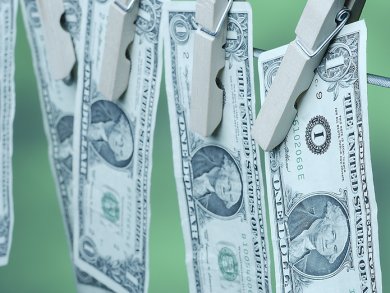Growing Problem
Banknote counterfeiting is a growing problem for fraud investigators across the globe and criminals involved in this highly profitable system are constantly developing their techniques to stay one step ahead of the authorities and their forensic detection methods. Now, researchers in Brazil and the US have taken a mass spectrometric approach that can produce a near-instantaneous chemical profile of a banknote to check against database entries and spot counterfeit notes very quickly.
Marcos Eberlin of the University of Campinas in Brazil and colleagues there and in Graham Cooks research group at Purdue University, in West Lafayette, Indiana, working with the Brazilian Federal Police in São Paulo, have demonstrated proof of principle with genuine currency from Brazil, the US, and the Euro zone.
Spotting Counterfeits
At one time, spotting a counterfeit banknote was a matter of checking its look and feel, or viewing watermarks and metal strips through the paper, an ultraviolet light might even be used to display a latent image. However, these can often be duplicated by enthusiastic counterfeiters. Encoded magnetic strips, diffraction patterns (commonly referred to as holograms), sophisticated security papers, and special printing techniques slow the counterfeiters but add to production costs of the money itself. Moreover, counterfeiters have increasingly sophisticated computational reproduction techniques that can defeat even expert examination.
Eberlin and colleagues explain that chemical analysis of suspect banknotes could provide a rapid and automated way of screen huge batches of banknotes and be a far more reliable way to detect forgery. As such, they have turned to recently developed desorption/ionization techniques for direct ambient mass spectrometry analysis, which they say can provide a robust fingerprint from a banknote without damaging the note.
Desorption electrospray ionization (DESI) and easy ambient sonic-spray ionization (EASI) mass spectrometry were developed by the teams of Cooks and Eberlin, respectively, in the mid-2000s. “DESI was the first of the now large family of ionization methods,” Cooks told ChemViews, “EASI is a derived and simplified experiment that works well for small molecules.” He adds that Marcos Eberlin, who was a visiting professor at Purdue in the early 1990s, initiated the banknote project and asked Cooks team to join. Team member Livia Eberlin, Marcos’ daughter is currently at Purdue.
Non-Destructive Methods
Both DESI and EASI are high-performance and non-destructive MS ionization methods that would work with condensed phase samples rather than solutions. Cooks points out that the pivotal point is that the experiments can be done in the ambient environment. The researchers have now used them to test genuine banknotes and real-world counterfeit notes from three of the most well-targeted economies for this crime – Brazil, US and Europe. Previously, these and related techniques had been coupled with two-dimensional chemically selective imaging analysis to identify counterfeit pharmaceuticals.
DESI is an ambient ionization technique that involves using an atmospheric pressure ion source, an electrically charged mist, to ionize gases, liquids and solids in the open air for MS detection. EASI, in contrast, uses a supersonic cloud of charged droplets to promote efficient desorption and ionization of material from the surface of a sample. Cooks adds that EASI differs from DESI most significantly, however, in not using an applied potential the droplets are not (deliberately) charged.
Homemade Banknotes
The team first tested the techniques using genuine Brazilian banknotes and compared the fingerprints with “homemade” banknotes produced on a readily available paper using different types of computer printer. They tested various points on the surface of the banknotes and obtained similar spectra regardless. They point out that the DESI-MS and EASI-MS spectra intriguingly also reflect the presence of surface contaminants, such as cocaine residues, on the banknotes. “The signals due to contaminants are present in widely varying amounts while the signals at masses corresponding to compounds used in production of authentic bills occur in reproducible signal strengths at mass values which are quite different and not easily confused with adventitious contamination,” Cooks adds. This point aside, the genuine banknotes showed almost identical spectra irrespective of denomination or age of the notes. The mass spectra for the copies produced on a laserjet or inkjet printer were very different.
Similar results were obtained with US dollar bills and Euro notes in terms of contaminants and the marked distinction between genuine notes and forgeries. There was also a readily seen difference in the spectra between Brazilian, US and European notes. The spectra obtained for “street” forgeries, obtained from the Brazilian police, were also readily distinguishable from those of the genuine banknotes. “The study relied mainly on these street bills, not on our crude attempts to produce fakes for testing. The mass spec data were taken to record compounds on the banknotes. In some experiments imaging was also done with mass spectrometry which of course gives chemical information too,” Cooks told ChemViews.
Expert Help
“Ambient MS could be used as a complementary technique to the traditional forensic microscopic inspection and help the expert in the case of dubious or more sophisticated samples. It could also be useful for the forensic scientist to link counterfeit bills to their production sites or to a particular brand, or even to a specific printer,” the researchers say.
- Instantaneous chemical profiles of banknotes by ambient mass spectrometry
L. S. Eberlin, R. Haddad, R. C. S. Neto, R. G. Cosso, D. R. J. Maia, et al.,
Analyst, 2010, 8.
DOI: 10.1039/c0an00243g -
Read about Australia’s approach to preventing conterfeiting >>>





